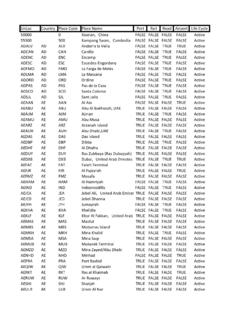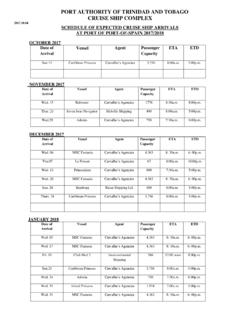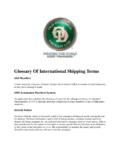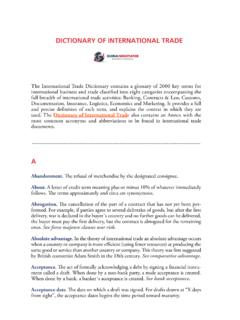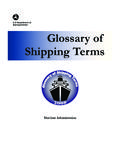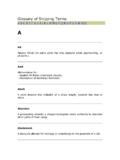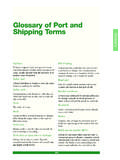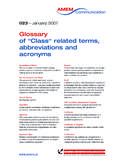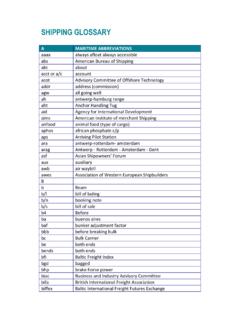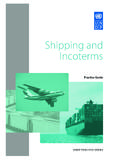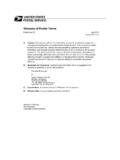Transcription of Glossary of Maritime Terms - Port of Port of Spain
1 Glossary of Maritime Terms ABS: The American Bureau of shipping is a classification society that certifies if a ship is in compliance with standard rules of construction and maintenance. anchorage: Port charge relating to a vessel moored at approved anchorage site in a harbor. apron: The area immediately in front of or behind a wharf shed on which cargo is lifted. On the "front apron," cargo is unloaded from or loaded onto a ship. Behind the shed, cargo moves over the "rear apron" into and out of railroad cars. Backhaul: To haul a shipment back over part of a route which it has already traveled; a marine transportation carrier s return movement of cargo, usually opposite from the direction of its primary cargo distribution. barge: A large, flat-bottomed boat used to carry cargo from a port to shallow-draft waterways.
2 Barges have no locomotion and are pushed by towboats. A single, standard barge can hold 1,500 tons of cargo or as much as either 15 railroad cars or 60 trucks can carry. A barge is 200 feet long, 35 feet wide and has a draft of 9 feet. Barges carry dry bulk (grain, coal, lumber, gravel, etc.) and liquid bulk (petroleum, vegetable oils, molasses, etc.). berth: (verb) To bring a ship to a berth. (noun) The wharf space at which a ship docks. A wharf may have two or three berths, depending on the length of incoming ships. bill of lading: A contract between a shipper and carrier listing the Terms for moving freight between specified points. Board of Commissioners: The members of the governing board of a port authority are called commissioners.
3 Members of a Board of Commissioners can be elected or appointed and usually serve for several years. bollard: A line-securing device on a wharf around which mooring and berthing lines are fastened. bonded warehouse: A building designated by Customs authorities for storage of goods without payment of duties to Customs until goods are removed. Box: Slang term for a container. breakbulk cargo: Non-containerized general cargo stored in boxes, bales, pallets or other units to be loaded onto or discharged from ships or other forms of transportation. (See also: bulk and container.) Examples include iron, steel, machinery, linerboard and woodpulp. bulk cargo: Loose cargo (dry or liquid) that is loaded (shoveled, scooped, forked, mechanically conveyed or pumped) in volume directly into a ship s hold; , grain, coal and oil.
4 Bulkhead: A structure used to protect against shifting cargo and/or to separate the load. Buoys: Floats that warn of hazards such as rocks or shallow ground, to help ships maneuver through unfamiliar harbors. cabotage: Shipment of cargo between a nation s ports is also called coastwise trade. The and some other countries require such trade to be carried on domestic ships only. capacity: The available space for, or ability to handle, freight. captive cargo port: When most of a port s inbound cargoes are being shipped short distances and most of its export products come from nearby areas, the port is called a captive cargo port. (Contrast with a transit port.) cargo: The freight (goods, products) carried by a ship, barge, train, truck or plane. Carrier: An individual, partnership or corporation engaged in the business of transporting goods or passengers (See also: ocean carrier.)
5 Cartage: Originally the process of transporting by cart. Today, the term is used for trucking or trucking fees. chandlers: Like a hotel at sea, a ship needs many supplies to operate and serve its crew-- groceries; paper products; engine parts; electronics; hardware; etc. A chandler sells these supplies to the ship s agent. Originally, chandlers (candle makers) provided illumination to ships. Over time they expanded the variety of products they could provide to ships. channels of distribution: The routes by which products are transported from origin to destination. This includes the physical routes, as well as the different companies involved in ultimately delivering the goods to buyers. checkers: See clerks. chock: A piece of wood or other material put next to cargo to prevent it from shifting.
6 Civil service: Some , state, city and parish government jobs are protected under civil service systems which are designed to provide a degree of security to employees and to deter nepotism, political patronage and arbitrary treatment of workers. clerks: When cargo is unloaded from a ship, a clerk checks the actual count of the goods (number of boxes, drums, bundles, pipes, etc.) versus the amount listed on the ship s manifest. He will note shortages, overages or damage. This is used to make claims if needed. common carrier: Trucking, railroad or barge lines that are licensed to transport goods or people nationwide are called common carriers. Conference rate: Rates arrived at by conference of carriers applicable to water transportation.
7 Consignment: A shipment of goods. The buyer of this shipment is called the consignee; the seller of the goods is called the consignor. Consolidated Freight Station or Container Freight Station (CFS)- Location on terminal grounds where stuffing and stripping of containers is conducted. consolidator: The person or firm that consolidates (combines) cargo from a number of shippers into a container that will deliver the goods to several buyers. container: A box made of aluminum, steel or fiberglass used to transport cargo by ship, rail, truck or barge. Common dimensions are 20' x 8 x 8' (called a TEU or twenty-foot equivalent unit) or 40' x 8' x 8', called an FEU. Variations are collapsible containers, tank containers (for liquids) and "rag tops" (open-topped containers covered by a tarpaulin for cargo that sticks above the top of a closed box).
8 In the container industry, containers are usually simply called boxes. container freight station: The facility for stuffing and stripping a container of its cargo, especially for movement by railroad. container chassis: A piece of equipment specifically designed for the movement of containers by highway to and from container terminals. container crane: Usually, a rail-mounted gantry crane located on a wharf for the purpose of loading and unloading containers on vessels. container terminal: A specialized facility where ocean container vessels dock to discharge and load containers, equipped with cranes with a safe lifting capacity of 35-40 tons, with booms having an outreach of up to 120 feet in order to reach the outside cells of vessels. Most such cranes operate on rail tracks and have articulating rail trucks on each of their four legs, enabling them to traverse along the terminal and work various bays on the vessel and for more than one crane to work a single vessel simultaneously.
9 Most terminals have direct rail access and container storage areas, and are served by highway carriers. containerization: The technique of using a container to store, protect and handle cargo while it is in transit. This shipping method has both greatly expedited the speed at which cargo is moved from origin to destination and lowered shipping costs. Container on Flat Car (COFC)- A container placed directly on a railroad flatcar without chassis. contraband: Goods prohibited in trade (such as weapons going to Iran, anything to Cuba). Smuggled goods. Corps of Engineers: This department of the U. S. Army is responsible for flood protection and providing safe navigation channels. The Corps builds and maintains the levees, flood walls and spillways that keep major rivers out of low lying communities.
10 The Corps is vital to keeping navigation channels open by dredging sand, silt and gravel that accumulate on river and harbor bottoms. craft: A boat, ship or airplane. customs: A duty or tax on imported goods. These fees are a major bonus to the economy. In 1999, for example, the U. S. Customs Department collected over $22 billion in fees nationally, which went into the Treasury. The Customs Department also works to prevent the importation of illegal drugs and contraband. customs broker: This person prepares the needed documentation for importing goods (just as a freight forwarder does for exports). The broker is licensed by the Treasury Department to clear goods through Customs. Performs duties related to documentation, cargo clearance, coordination of inland and ocean transportation, dockside inspection of cargo, etc.


